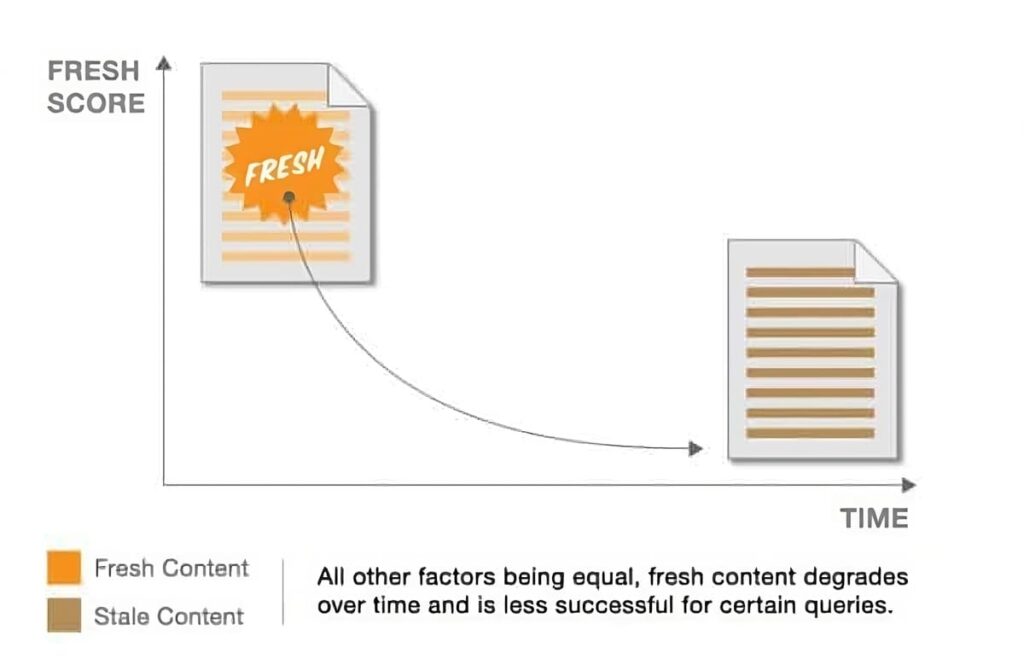Ever heard of the Pareto principle or 80/20 rule?
It’s the theory that states that roughly 80% of the effects come from 20% of the causes.
Why am I telling you this?
Because it applies to your website’s content.
Take a look at your content. How well is it ranking?
If you’re not ranking in the top 10 on Google for your main keyword or, even worse, you were ranking but you aren’t anymore, then maybe it is time for a content audit.

In this article you will learn how to find content in need of a refresh, how to actually go about improving it to boost your SEO as well some useful content re-optimisation tools.
Sound good?
Content audits are also extremely helpful after buying a website or blog. The audit helps you to get more familiar with the site’s content and find opportunities for quick wins.
What Is A Content Audit?
A content audit or SEO audit is an exercise in which you evaluate the performance of your existing content inventory (blog posts, FAQs, guides, lead magnets etc.), identify its weaknesses, and make improvements.
These improvements are done by adding new content, editing the existing content, or refreshing and updating your published content to make it more accurate and relevant.
It is one of the low hanging fruits in SEO and content marketing.
Why?
Because your old content is already indexed in Google Search (even if it’s nowhere near page 1), ranking for a few keywords, and pulling in some traffic.
Plus, it’s much more cost-effective to edit and upgrade old content and build on its success instead of creating a new piece of content from scratch.
Just a word of warning though:
A content audit/refresh doesn’t mean completely gutting your old stuff to make way for the new.
This could seriously impact your rankings and traffic.
Instead, think of a content refresh as a chance to improve content and bring older pieces up to the standard of newer ones.
But why should you do this? I’m glad you asked:
Why content (sometimes) needs refreshing
Sometimes content needs updating because of increased competition, maybe you’ve recently purchased a site and it is poorly optimized, or the content could be improved by sharing more examples or stats or maybe the information is simply outdated.
In some cases, you might update your content even if it’s ranking well and bringing in a lot of traffic just to strengthen your position even more.
To start your content audit, you first need to find the content that needs to be improved.
To be more specific look for the following things in your content.
- Loss of organic traffic or possible even NO organic traffic.
- No direct engagement (low time on page and other engagement metrics).
- Little to no social engagement.
- Poor post metrics.
- No follow through to content despite social promotion.
How to find underperforming content
Now you know what you are looking for, it’s time to get to work.
Here is what you’ll need:
- Google Analytics
- Google Search Console
- Ahrefs
- A copy of this Google Sheet.
First you need to make a copy of the Google Sheet.
Now it’s time to gather up your website data and add it into this sheet:
Step 1 – Get Google Analytics data
First up, we need to get pageviews from Google Analytics:
- Go to Google Analytics >>> Behavior >>> Site Content and the select All Pages
- Change your date range to show the last 6 months of data and hit apply.
- Depending on the size of your site: select more rows to show. I like to show 1000.
- Now export to CSV.
- In the sheet, go to the analytics tab. Click File >>> Import
- And make sure you select ‘Replace current sheet’ and then Import data.
Step 2 – Get Google Search Console data
Next up is to head over to Google Search Console:
- Select your site
- Got to the Performance report
- Make sure all the metrics are selected (clicks, impressions, CTR and average position)
- Change the date range to Last 6 months
- Now select Pages and export (the small arrow above the data)
- In the sheet, go to the search console tab. Click File >>> Import
- And make sure you select ‘Replace current sheet’ and then Import data.
Step 3 – Run your URLs through Ahrefs batch analysis
This is an optional step.
If you don’t have access to Ahrefs, the spreadsheet will still work, you’ll just be missing some keyword and backlink data.
We’ll be using the Batch Analysis tool that quickly gets a bunch of data for domains or URLs in bulk. To get it setup:
- Go the the Batch Analysis tool over at Ahrefs
- In the Overview tab of the sheet, copy the URLs (column B)
- Paste them into the batch analysis box.
- Underneath there are three option boxes, make sure you set it up like this:
- Protocol – As specified
- Target mode – Exact URL
- Index – Live
- Now hit analysis
- Now export
- Go back to your sheet and go to the ahrefs tab. Click File >>> Import
- And make sure you select ‘Replace current sheet’ and then Import data.
Now you’ll have a finished spreadsheet full of underperforming content that is ripe for a content refresh. Your content audit spreadsheet should look something like this:

What does this spreadsheet show you?
This Google Sheets seo content audit template gives you a quick top level view of your site and how it is performing.
It shows your website’s:
- Top 100 viewed pages
- The average position in the SERPs
- How users are interacting with your site on Google
- How many backlinks it has
- The keywords it ranks for
At a glance, you’ll be able to look for pages that are in need of a refresh. Here’s just a few ideas of things to look for:
Pages that have high impressions but low CTR.
Low search CTR means that people are seeing your site in search results but not clicking on it.

There are three things you need to see here
- Are You Ranking For The Right Keyword?
Does your site match the searcher’s internet for this keyword? Does your page have the answers the searchers of this keyword are looking for?
For example, you might have a site about fruits and nutrition that’s ranking for the keyword “apple benefits”.
But what if all the other results are about Apple the tech company?
That’s just an example.
But it’s possible that you’re ranking for the wrong keywords which is why no one’s clicking on your page.
In that case, try aiming for long-tail keywords on the same topic that are more descriptive.
- Improve Your Page Title:
Does your page title clearly tell the visitors what it’s about? Does it create a sense of curiosity? Does it make a promise? Is it using power words to drive action?
Without creating a power title, you’ll always struggle to drive clicks on your search result even if you rank for a keyword.
Here’s a really good resource for creating blog headlines.
- Write An Engaging Meta Description
Does your page have a meta description?
If it doesn’t Google will use the first few lines of your page as the default meta description.
And that’s not good from your perspective.
Meta descriptions do not impact search rankings directly. But thy have a huge role in driving clicks om your search result.
You need to write an engaging meta description that immediately makes a promise and entices the searches to click on your search result.
This is the place where you need to show your creative writing talent.
If your target keyword has sponsored results from Google Ads, look at the meta description they’ve used because advertisers pay a lot of money to test and optimize their ad descriptions.
Pages with crazy good CTRs
It’s always good to be on the lookout for outliers. Sometimes you’ll have a page that gets a really high CTR (or other metric).
During your SEO audit, it’s worth digging down into this and to try and reverse engineer what is working for other pages.

For the pages that are driving traffic, you need to pay particular attention to Bounce Rates
If the Bounce Rate is higher than your site average, it means the visitors are not finding the information they’re looking for.
In this case, you need to improve your content and make it more valuable. Try to highlight the key items of the page at the start so that the visitors know their desired information is available.
If the Bounce Rate is fine, see how much on-site conversions this traffic is driving (for example, visitor to email subscriber conversion, clicks on internal links, etc.)
The pages that are driving search traffic are your biggest assets. Always use content upgrades, lead magnets, internal links, and CTA to convert them into something more meaningful for your business.
Pages ranking for lots of keywords
If you find pages that are ranking for lots of keywords and have a decent CTR, but aren’t retaining the traffic or routing it to the other pages on your site, then these are definitely pages ripe for a content refresh.
Chances are you need to add more content to the page and/or target the keywords better.

The easiest way to do this is by analyzing your closest search competitors.
See how they’ve structured their content and what’s their main value proposition.
Structure your content on their model and try to offer something valuable to your visitors so that they stick on your site.
5 ways to perform an effective content refresh
Okay, so now you know what content refreshing is, why it’s important and you’ve (hopefully) identified your target pages.
Now starts the actual refreshing.
When it comes to actually refreshing your content, you’ve got five types of things you can do to boost it.
- Expand your content
- Update your content
- Optimise or re-optimise
- Merge it
- Promote / build some links
Let’s look at these in more detail.
#1 Expand your content
Expanding your content is the most common way of refreshing a post.
Sometimes you just need to write something longer and more in depth.
There’s lots of data to suggest that content needs to be longer in order to rank highly.
In fact, if this Backlinko study is to be believed, the average word count of a Google first page result is 1,890 words.

Longer content also tends to attract more backlinks and generate more social share.
And it makes sense.
Content that is more in-depth generally offers more value to the readers as a result of which more people link to it.
Your starting point for expanding content is keyword research.
You need to know if your content is or isn’t optimized for any of the keywords that are going to drive traffic to your site.
By performing keyword research, you’ll be able to see what gaps are in your content you can fill in.
However, avoid just expanding content for the sake of it. Be critical and ask yourself:
Should I expand this post?
Are there questions about this topic that I haven’t answered?
Is my resource giving comprehensive information to the readers?
An easy way to find this is by looking at the “People also ask” section of SERPs for your target keyword.
In this section, Google lists the most common questions people have about a topic.
Quickly go through the list and see if there are any angles or topics that you can add to your content to make it more valuable.
Maybe your original post lacked context or needed some supporting info to make it more relevant, or perhaps missed out a topic completely.
Either way, be sure to do a quality check on your content before diving in and expanding it.
Another aspect of expanding your content is to add things that make it more impactful and credible.
For example, if you’ve shared a strategy or tips about achieving something, why not share a couple of real-life examples with it to give the readers more value?
Similarly, if you’ve made a claim or shared an opinion in your content, why not back it up with solid research or scientific data evidence so that your arguments become heavier.
These things make your content more effective and leave an impact on your readers.
#2 Update your content
Google likes fresh content for some searches and sometimes information can become outdated. Your site audit helps identify these issues.

Here’s the type of posts you should look out for and consider updating:
- Posts that mentions of dates
- Posts with lots of screenshots (especially of software tools as these get updated and re-skinned)
- Outdated information
- Topics that have since changed
You want your content to be as accurate as possible for both users and Google.
It’s quite common that over time information in content can become outdated.
Here’s a quick list of things you can change, add, or remove from outdated posts:
- Remove any content that is no longer relevant.
- Update any outdated content.
- Replace outdated data with up to date ones
- Update screenshots if things have changed
- Add any new best practices that have emerged (things in SEO change fast)
- Check and update internal links
- Potentially update CTAs
#3 Optimize or re-optimize
Sometimes content drops off because it could be better optimised.
On-page SEO plays a big part in how your content is performing, so make sure to check the following for the best rankings:
- Ensure the title tag includes the main keyword.
- Use a H1 that also includes the main keywords.
- Add a meta description.
- Use variations of your main keyword in subheadings.
- Add keywords to the URL (but keep it short)
- Optimise images – compress them and add relevant alt text.
- Check on technical issues like page load speed
- Make sure your site uses a responsive design that’s easily accessible from mobile devices as well.
- Add more internal links to your content wherever they make sense.
Another easy way to improve your ranking is to look for the keywords that you’re already ranking for in search results on Page 2 and 3.
You can find them in Google Search Console.
You’ll be surprised to see that your content might not even be optimized for some of the keywords you’re ranking for.
Filter them out and naturally include them in your content where they make sense.
#4 Merge Similar Content
So you’ve been blogging for a while and now your website is full of content.
Chances are though, there will be some duplicate or overlapping topics going on.
If this is the case, consider merging multiple blog posts together.
Having one strong resource on a topic that covers it in-depth is better than a handful of articles that all include roughly the same information.
If you’ve done your keyword research, you should have a list of related keywords, so should be able to plan out what keywords can be grouped together in a single post. You can then scale this by using content templates.
The end goal here is to have a few high-quality articles on your site vs lots of mediocre ones.
#5 Promote it / Build some links
Sometimes, a new round of promotion and link building is all that’s required to improve your digital marketing.
If you are looking to perform a content refresh on old content, chances are you have published lots of new content since then.
This is a great opportunity to build internal links to it and improve your content marketing success.
A quick site search will show you lots of internal link opportunities. Just head to Google and search:
site:URL KEYWORD
(example site:rankxl.com content marketing)
Switch out KEYWORD to the main topic of the blog post you want to build links to.
Google will show you the pages on your site it thinks are related.
These make great targets to go add internal links from.
Don’t forget you can also re-promote old content to your email list of on social media as if it was new content and even consider driving paid traffic to it.
For higher competition keywords, you might need to build some new (and more powerful) links to it like via methods like guest posts or running some broken link building.
Don’t forget, the type of site you want to improve will dictate the type of links you need to build to it.
A local lead gen site needs local links, whereas a more recognized branded site could use unlinked brand mentions whilst an affiliate site might be better off with white hat outreach.
Consider this before blindly going out and building any links you can.
Sidenote: 8 tools to help improve your content
Updating your content can be hard work.
Thankfully, there are some useful tools out three to make your life a bit easier.
Here’s a brief list of free and paid tools you can use to help improve your content:
- Google Analytics [FREE] – see how many people are visiting your site + other metrics
- Google Search Console [FREE] – see how your site is performing in search engines
- Ahrefs [PAID] – use this for keyword research and for spying on competitors
- Clearscope [PAID] – an AI tool to get the most out of content
- Frase [PAID] – a cheaper AI tool for analysing content.
- Headline Analyzer [FREE] – see how you can improve your headline/page titles
- AnswerthePublic [FREE] – use this to find question-related keywords
- Buzzsumo [PAID] – find what content is working well in your niche.
Summary
Refreshing pages doesn’t have to be a chore or seen as a step back.
Sometimes, refreshing old content will have a more positive effect on your traffic than creating more content.
Afterall, 80% of your traffic is likely to come from 20% of your content.
Remember: search engine optimization is not a one time task.
It’s an ongoing process.
To get the most from a content refresh, get in the habit of performing one on your site every 3 – 6 months.
There’s always room for improvement, you just have to look in the right places.

SEO Plate Spinner + Creator at Sheets for Marketers
Jake is a marketer, writer and spreadsheet wrangler who runs Sheets For Marketers. He’s a fan of dogs, SEO, and pizza. Sometimes at the same time..
Connect with Jake:
Linkedin | X | Facebook | Sheets for Marketers

